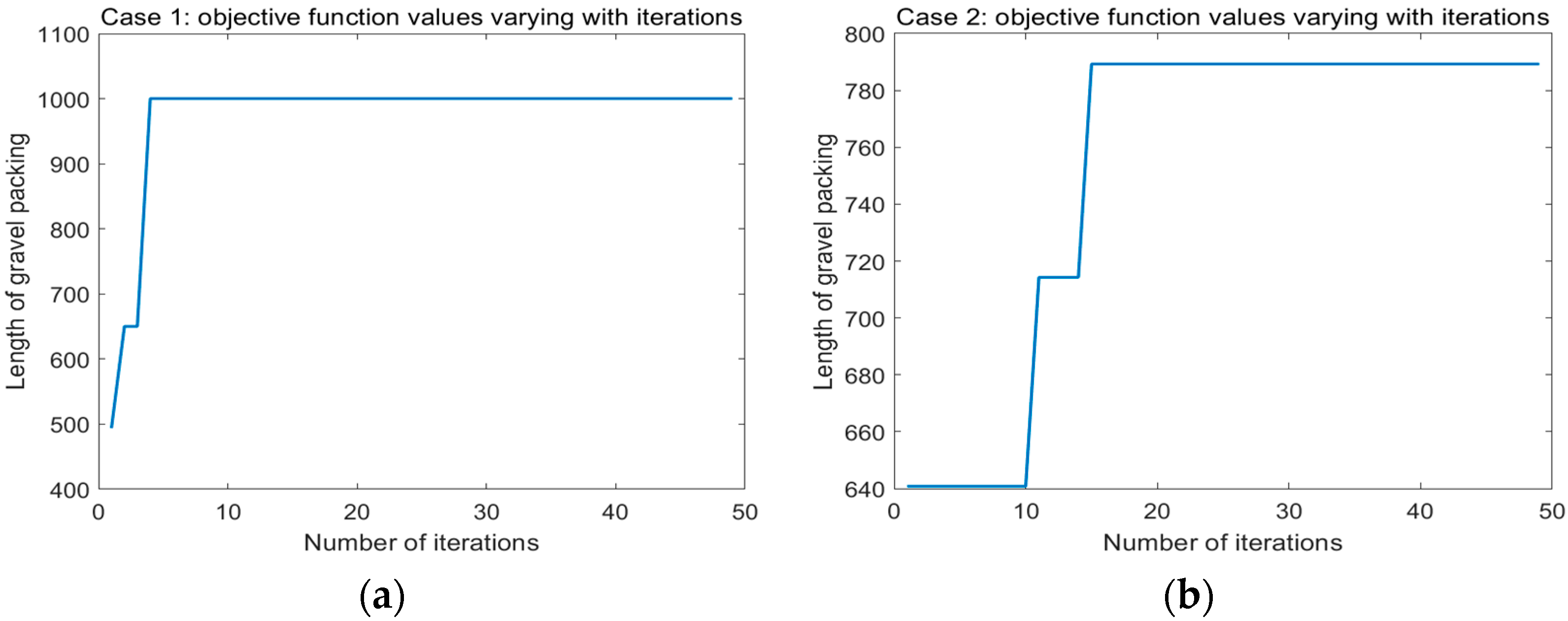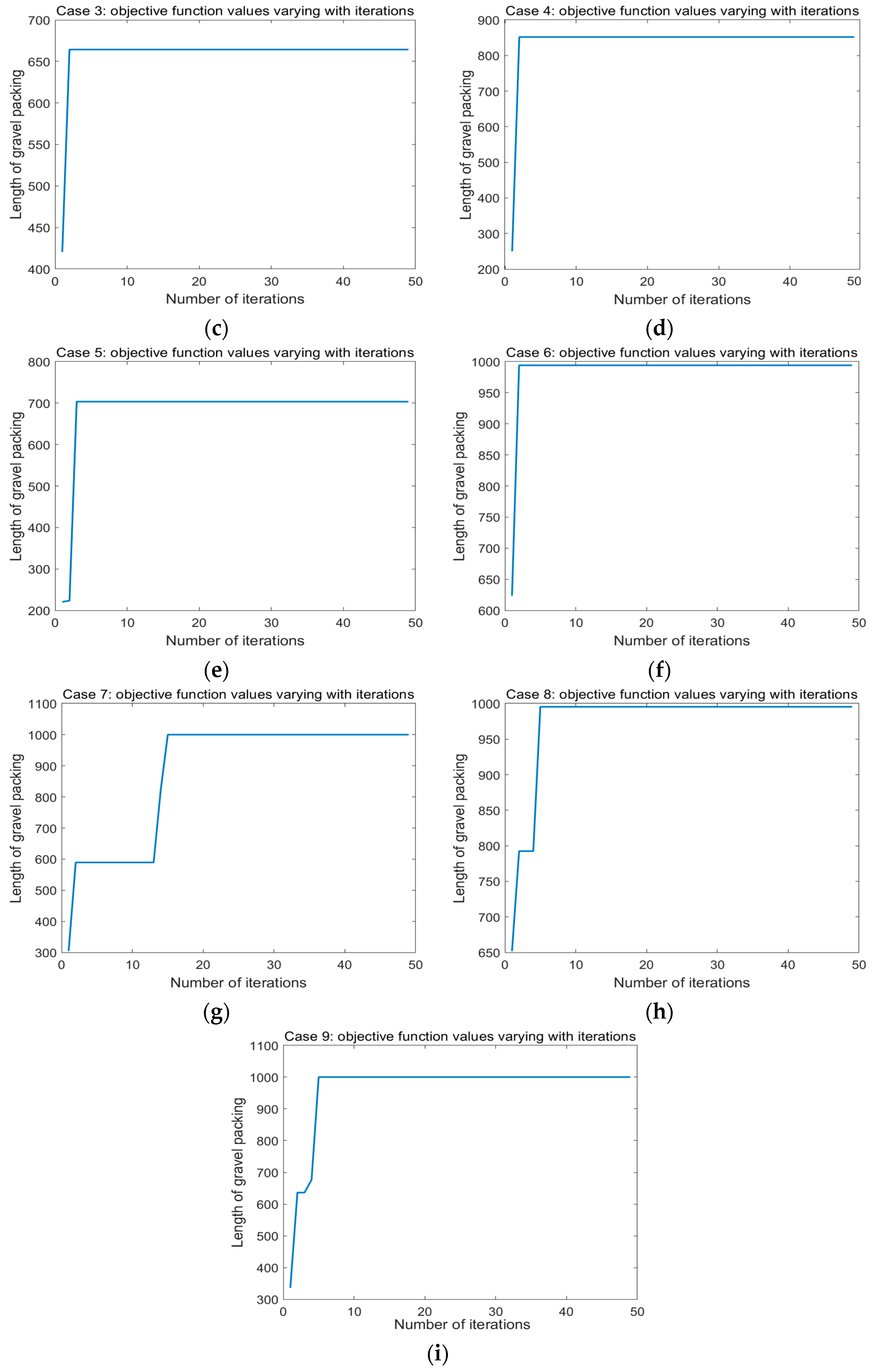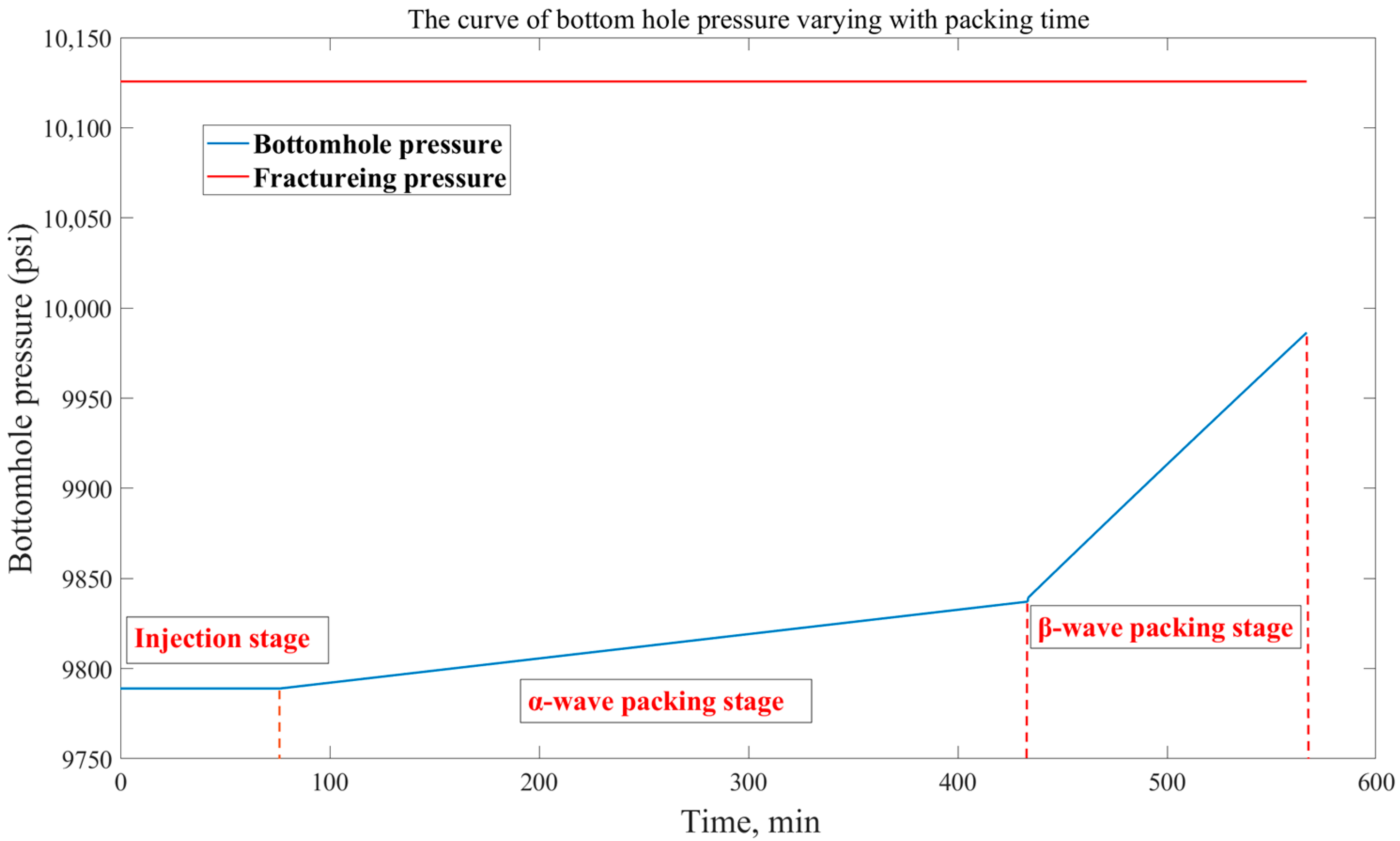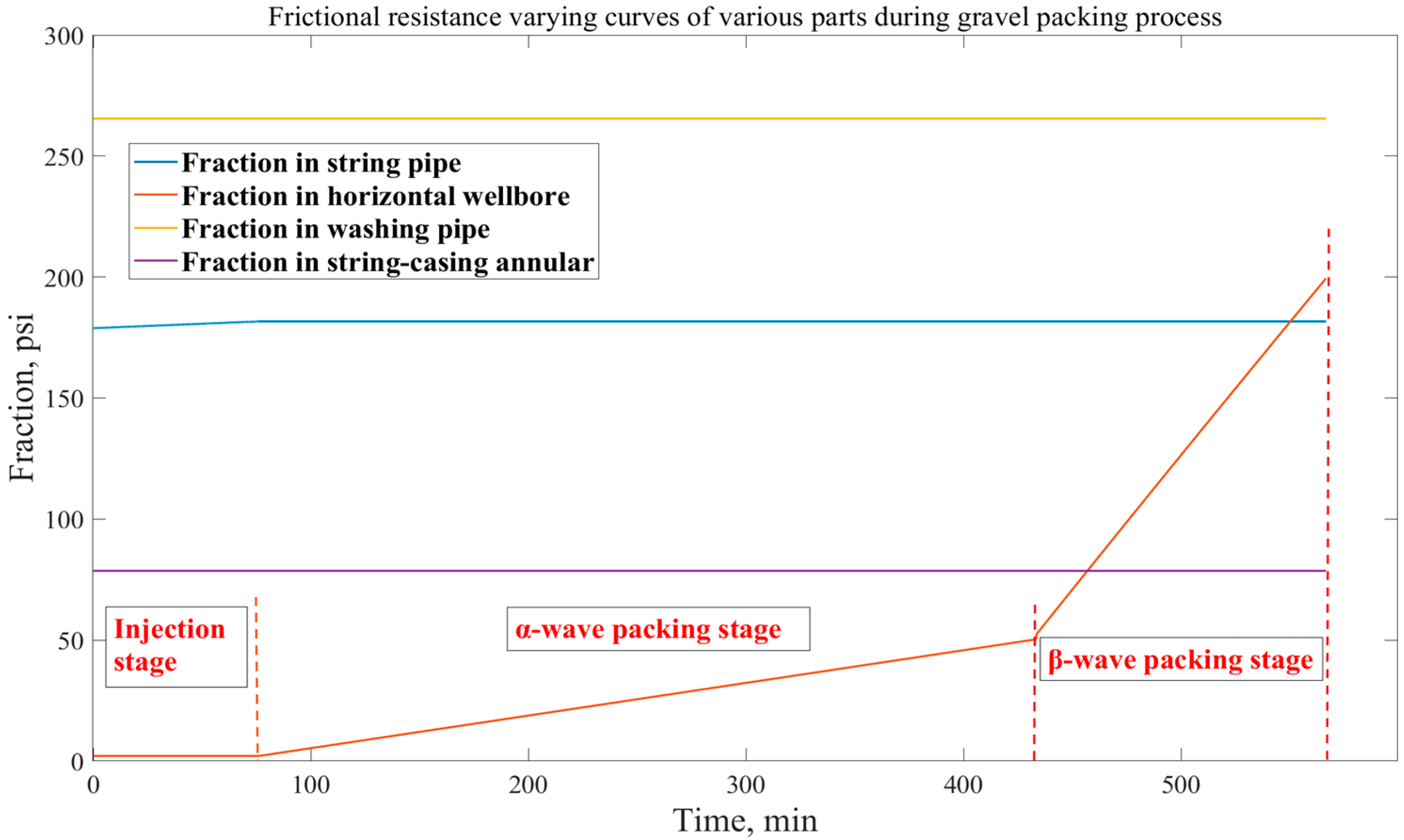An Improved Artificial Electric Field Algorithm for Determining the Maximum Length of Gravel Packing in Deep-Water Horizontal Well
Abstract
:1. Introduction
2. Description of Gravel Packing Flow in Deep-Water Horizontal Well
2.1. Equilibrium Velocity and Equilibrium Sand Dune of α-Wave Packing
2.2. Flow Friction Resistance of Gravel Packing in Deep-Water Horizontal Well
2.2.1. Injection Stage
2.2.2. α-Wave Packing Stage
2.2.3. β-Wave Packing Stage
3. Optimization Model for Maximizing the Length of Gravel Packing
3.1. Achievable Gravel Packing Length
- (1)
- The α-wave packing must be capable of completing the packing of the entire horizontal wellbore section, meaning that the packing length of the α-wave () should reach the design length of the entire horizontal wellbore (), i.e., = .
- (2)
- The β-wave packing must also be able to complete the packing of the entire horizontal wellbore section, indicating that the packing length of the β-wave () should reach the design length of the entire horizontal wellbore (), i.e., = .
3.2. Optimization Model
4. IAEFA for Determining the Maximum Length of Gravel Packing
4.1. Standard AEFA Algorithm
4.2. Improvement Strategy of IAEFA Algorithm
5. The Proposed Research Framework
6. Case Study and Result Discussion
6.1. Basic Parameters and Optimization Variables
6.2. Optimization Results Obtained by IAEFA
6.3. Simulation Results of Gravel Packing under Optimal Packing Parameters
7. Conclusions
Author Contributions
Funding
Institutional Review Board Statement
Informed Consent Statement
Data Availability Statement
Conflicts of Interest
References
- Yu, Z.; Amdahl, J. A review of structural responses and design of offshore tubular structures subjected to ship impacts. Ocean Eng. 2018, 154, 177–203. [Google Scholar] [CrossRef]
- Jeanpert, J.; Banning, T.; Abad, I.; Mbamalu, J. Successful installation of horizontal openhole gravel-pack completions in low fracture gradient environment: A case history from deepwater West Africa. In Proceedings of the SPE International Conference and Exhibition on Formation Damage Control, Lafayette, LA, USA, 21 February 2024; SPE: Kuala Lumpur, Malaysia, 2018; p. 189492-MS. [Google Scholar]
- Ali, S.; Grigsby, T.; Vitthal, S. Advances in horizontal openhole gravel packing. SPE Drill. Complet. 2006, 21, 23–30. [Google Scholar] [CrossRef]
- Weaver, J.; Knox, J. Evaluation of Steam Resistance of Gravel-Packing Materials. SPE Prod. Eng. 1992, 7, 155–159. [Google Scholar] [CrossRef]
- Johnson, P.; Williams, R. A novel cyclic gravel packing method for offshore horizontal wells. SPE Drill. Complet. 2019, 34, 132–140. [Google Scholar]
- Gruesbeck, C.; Salathiel, W.M.; Echols, E.E. Design of gravel packs in deviated wellbores. J. Pet. Technol. 1979, 31, 109–115. [Google Scholar] [CrossRef]
- Lee, K.; Kim, H. Multi-physics coupling model for predicting gravel pack stability and durability. J. Pet. Technol. 2020, 72, 56–63. [Google Scholar]
- Zhou, S.; Li, Z.; Dong, C. The advances of numerical simulation for gravel packing in horizontal wells. Mech. Eng. 2009, 31, 9–15. [Google Scholar]
- Li, A.; Yang, L. Numerical simulation study of gravel packing in horizontal well. Acta Pet. Sin. 2002, 23, 102–106. [Google Scholar]
- Pillai, P.; Lin, C.C.; Brege, J.; Mohan, R.; Mohan, E. Industry first openhole alternate path gravel pack completion in hpht environment: Fluid development and case history. In Proceedings of the SPE Annual Technical Conference and Exhibition, Dubai, United Arab Emirates, 21–23 September 2021; SPE: Kuala Lumpur, Malaysia, 2021; p. 206048-MS. [Google Scholar]
- Alexander, K.; Bruce, D.; Williamson, C.; Moses, N.; Ismayilov, E. Evolution of open-hole gravel pack methodology in a low frac-window environment: Case histories and lessons learned from the Kraken field development. In Proceedings of the SPE Annual Technical Conference and Exhibition, Calgary, AB, Canada, 30 September–2 October 2019; SPE: Kuala Lumpur, Malaysia, 2019; p. 195937. [Google Scholar]
- Rice, R. A Case Study of Plastic Plugbacks on Gravel Packed Wells in the Gulf of Mexico. In Proceedings of the SPE Production Operations Symposium, Oklahoma, OK, USA, 7–9 April 1991; SPE: Kuala Lumpur, Malaysia, 1991; p. 21671-MS. [Google Scholar]
- Johnson, P.; Lee, K. Numerical modeling of flow behavior within open-hole gravel packs in offshore wells. J. Pet. Technol. 2018, 70, 43–50. [Google Scholar]
- Rodrigues, K.; Kevin, W.; Lawrence, R.; Kerimov, N.; Henry, I.; Brune, L.; Spicer, J.; Nwafor, C.; Gutierrez, C.; Filbrandt, J. Application of new technologies to GoM for a successful open hole gravel pack. In Proceedings of the SPE International Conference and Exhibition on Formation Damage Control, Lafayette, LA, USA, 19–21 February 2020; SPE: Kuala Lumpur, Malaysia, 2020; p. 199338. [Google Scholar]
- Wen, M.; Huang, H.; Zhou, S.; Fan, B.; Qiu, H. Friction calculation and packing effect analysis for gravel packing in deepwater horizontal wells. Energy Sci. Eng. 2021, 9, 2380–2387. [Google Scholar] [CrossRef]
- Yu, Y.; Jiang, D.; Wang, H.; Diao, H.; Xiao, T.; Zhou, S. Simulation and application analysis of gravel packing in deepwater HT/HP wells. Energy Sci. Eng. 2022, 10, 3908–3917. [Google Scholar] [CrossRef]
- Gupta, V.; Jeanpert, J.; John, C.; Bose, R.; Agrawal, V. Elements in openhole gravel pack treatment design cycle: Case study in Indian ultra-deepwater. In Proceedings of the SPE Asia Pacific Oil & Gas Conference and Exhibition, Virtual, 17–19 November 2020; SPE: Kuala Lumpur, Malaysia, 2020; p. 202296-MS. [Google Scholar]
- Zhang, J.; Wang, L.; Li, H.; Chen, S. Numerical Investigation of Gravel Packing Process in Deepwater Horizontal Wells Considering Particle-Fluid Interactions. J. Pet. Sci. Eng. 2023, 230, 1–14. [Google Scholar]
- Smith, R.M.; Johnson, A.B. Advanced Simulation of Gravel Pack Performance in Complex Deepwater Environments. SPE J. 2022, 27, 2423–2438. [Google Scholar]
- Lee, K.H.; Kim, J.Y.; Park, C. W Optimization of Gravel Pack Design for Enhanced Production and Sand Control in Deepwater Horizontal Wells: A Numerical Study. J. Nat. Gas Sci. Eng. 2021, 8, 103591. [Google Scholar]
- Chen, X.; Yang, Y.; Liu, H. Dynamic Modeling and Simulation of Foam-Assisted Gravel Packing in Deepwater Horizontal Wells. J. Energy Resour. Technol. 2020, 142, 112901–112912. [Google Scholar]
- Wang, M.; Zhang, X.; Zhou, D. Numerical Analysis of Gravel Packing Effectiveness in Deepwater Horizontal Wells with High-Angle Deviations. SPE Drill. Complet. 2019, 34, 269–280. [Google Scholar]
- Wu, J.; Li, Z.; Yang, Z. Experimental and Numerical Study on the Flow Behavior of Gravel-Packing Fluids in Deepwater Horizontal Wells. J. Pet. Explor. Prod. Technol. 2018, 8, 1109–1121. [Google Scholar]
- Liu, Y.; Huang, H. Simulation of Complex Flow Dynamics During Gravel Packing in Deepwater Horizontal Wells Using CFD Methods. J. Pet. Sci. Eng. 2017, 158, 710–722. [Google Scholar]
- Zhang, L.; Guo, H. Optimization of Gravel Pack Design for Sand Control in Deepwater Horizontal Wells Based on Numerical Simulation. J. Nat. Gas Sci. Eng. 2016, 3, 1257–1267. [Google Scholar]
- Park, S.; Choi, K. Numerical Investigation of Particle Transport and Deposition During Gravel Packing in Deepwater Horizontal Wells. J. Pet. Technol. Altern. Fuels 2015, 6, 162–173. [Google Scholar]
- Kim, J.; Kim, M. Advanced Simulation of Gravel Packing Performance Considering Non-Newtonian Fluid Behavior in Deepwater Horizontal Wells. SPE Reserv. Eval. Eng. 2014, 17, 359–370. [Google Scholar]
- Zhang, J.; Liu, H. Enhanced Optimization of Gravel Pack Design for Deepwater Horizontal Wells Based on CFD-PSO Hybrid Method. SPE J. 2023, 28, 3456–3470. [Google Scholar]
- Kim, M.; Choi, K. Multi-Objective Optimization of Gravel Packing in Horizontal Wells Considering Production Efficiency and Sand Control. J. Nat. Gas Sci. Eng. 2022, 9, 106873. [Google Scholar]
- Wu, X.; Wang, D.; Chen, Z. Intelligent Optimization of Gravel Packing Parameters for Horizontal Wells in Unconsolidated Reservoirs. J. Pet. Explor. Prod. Technol. 2021, 11, 1435–1448. [Google Scholar]
- Liu, Y.; Zhang, L. Optimization of Foam-Assisted Gravel Packing in Horizontal Wells Using a Coupled CFD-Particle Tracking Approach. SPE Prod. Oper. 2020, 35, 0569–1897. [Google Scholar]
- Chikwe, A.; Nwanwe, O.; Duru, U.; Nduwuba, G.O.; Duruonyeaku, A.N. Investigating the Impact of Sieve Analysis on the Choice of Gravel Pack Design for Wells in Unconsolidated Sandstone Formations in the Niger Delta. J. Eng. Res. Rep. 2023, 24, 39–49. [Google Scholar] [CrossRef]
- Peng, H.; Li, X.; Chen, Z.; Zhang, Y.; Ji, Y. Effect of gravel pack permeability on horizontal well productivity loss under secondary methane hydrate formation: Experimental optimization of 3D randomly distributed mixed sand pack. Appl. Energy 2024, 371, 123663. [Google Scholar] [CrossRef]
- Martins, A.L.; de Magalhaes, J.V.M.; Ferreira, M.V.D.; Calderon, A.; de Sa, A.N. Sand control in long horizontal section wells. In Proceedings of the Offshore Technology Conference, Houston, TX, USA, 1 January 2009. [Google Scholar]
- Martins, A.L.; de Magalhães, J.V.M.; Calderon, A.; Chagas, C.M. A mechanistic model for horizontal gravel-pack displacement. SPE J. 2005, 10, 229–237. [Google Scholar] [CrossRef]
- Anita; Yadav, A. AEFA: Artificial electric field algorithm for global optimization. Swarm Evol. Comput. 2019, 48, 93–108. [Google Scholar] [CrossRef]
- Cheng, J.; Xu, P.; Xiong, Y. An improved artificial electric field algorithm and its application in neural network optimization. Comput. Electr. Eng. 2022, 101, 108111. [Google Scholar] [CrossRef]







| Parameter | Value |
|---|---|
| Water depth (m) | 910 |
| Vertical depth (m) | 4060 |
| Fracture pressure gradient | 1.72 |
| Fracture pressure (MPa) | 69.83 |
| Pressure coefficient | 1.49 |
| Pore pressure (MPa) | 60.49 |
| Formation temperature (°C) | 134.67 |
| Loss-off ratio | 6.5% |
| Openhole diameter (mm) | 216.9 |
| Parameter | Range of Value |
|---|---|
| Pump rate (bpm) | 4~10 |
| Density of the sand carrying fluid (Kg/m3) | 1.59~1.72 |
| Density of gravel particle (Kg/m3) | 1.25~2.5 |
| Average diameter of gravel particle (mm) | 0.334~0.502 |
| Sand ratio (volumetric concentration of gravel slurry) | 0.3~0.8 |
| Inner diameters of screen pipe (mm) | 100~129 |
| Outer diameters of screen pipe (mm) | 130~180 |
| Inner diameters of washing pipe (mm) | 70~79 |
| Outer diameters of washing pipe (mm) | 80~99 |
| No. | b | c | N | ||
|---|---|---|---|---|---|
| Case 1 | 30 | 50 | 25 | 0.9~0.4 | 2.25~0.25 |
| Case 2 | 20 | 50 | 25 | 0.9~0.4 | 2.25~0.25 |
| Case 3 | 40 | 50 | 25 | 0.9~0.4 | 2.25~0.25 |
| Case 4 | 30 | 40 | 25 | 0.9~0.4 | 2.25~0.25 |
| Case 5 | 30 | 60 | 25 | 0.9~0.4 | 2.25~0.25 |
| Case 6 | 30 | 50 | 20 | 0.9~0.4 | 2.25~0.25 |
| Case 7 | 30 | 50 | 30 | 0.9~0.4 | 2.25~0.25 |
| Case 8 | 30 | 50 | 25 | 0.7~0.2 | 2.05~0.05 |
| Case 9 | 30 | 50 | 25 | 1.1~0.6 | 2.45~0.45 |
| No. | Maximum Packing Length | Optimum Packing Parameter | ||||||||
|---|---|---|---|---|---|---|---|---|---|---|
| Case 1 | 1000.22 | 4.61 | 1606.37 | 1523.35 | 0.63 | 0.36 | 172.65 | 124.75 | 85.84 | 74.60 |
| Case 2 | 789.28 | 5.19 | 1622.56 | 2482.80 | 0.62 | 0.40 | 172.64 | 123.26 | 86.71 | 77.69 |
| Case 3 | 664.28 | 5.06 | 1641.03 | 2069.01 | 0.68 | 0.42 | 164.74 | 128.21 | 86.23 | 77.54 |
| Case 4 | 851.78 | 4.59 | 1618.57 | 2224.77 | 0.68 | 0.44 | 153.59 | 120.35 | 82.81 | 71.81 |
| Case 5 | 703.34 | 6.47 | 1604.42 | 2036.60 | 0.51 | 0.40 | 153.00 | 128.59 | 81.37 | 76.79 |
| Case 6 | 993.97 | 5.78 | 1593.42 | 2144.46 | 0.74 | 0.45 | 139.06 | 125.17 | 83.01 | 75.91 |
| Case 7 | 1000.22 | 5.53 | 1597.99 | 2226.89 | 0.77 | 0.41 | 164.00 | 121.41 | 81.15 | 76.38 |
| Case 8 | 995.53 | 5.45 | 1606.89 | 2087.92 | 0.47 | 0.34 | 174.86 | 125.50 | 81.72 | 77.32 |
| Case 9 | 1000.22 | 4.77 | 1600.39 | 2360.57 | 0.55 | 0.35 | 149.29 | 115.07 | 82.30 | 77.11 |
(bpm) | (Kg/m3) | (Kg/m3) | (mm) | (mm) | (mm) | (mm) | (mm) | |
|---|---|---|---|---|---|---|---|---|
| 4.77 | 1600.39 | 2360.57 | 0.55 | 0.35 | 149.29 | 115.07 | 82.30 | 77.11 |
| Result Item | Value |
|---|---|
| Design length (m) | 1000.22 |
| α-wave packing length (m) | 1000.22 |
| β-wave packing length (m) | 1000.22 |
| Total time for gravel packing (min) | 566.60 |
| Injection stage time (min) | 76.29 |
| α-wave packing time (min) | 357.13 |
| β-wave packing time (min) | 133.18 |
| Total amount of sand consumption (lbs) | 54,050.94 |
| Amount of sand consumption in α-wave packing (lbs) | 39,369.08 |
| Amount of sand consumption in β-wave packing (lbs) | 14,681.87 |
Disclaimer/Publisher’s Note: The statements, opinions and data contained in all publications are solely those of the individual author(s) and contributor(s) and not of MDPI and/or the editor(s). MDPI and/or the editor(s) disclaim responsibility for any injury to people or property resulting from any ideas, methods, instructions or products referred to in the content. |
© 2024 by the authors. Licensee MDPI, Basel, Switzerland. This article is an open access article distributed under the terms and conditions of the Creative Commons Attribution (CC BY) license (https://creativecommons.org/licenses/by/4.0/).
Share and Cite
Yang, L.; Lin, H.; Zhou, S.; Feng, Z. An Improved Artificial Electric Field Algorithm for Determining the Maximum Length of Gravel Packing in Deep-Water Horizontal Well. J. Mar. Sci. Eng. 2024, 12, 1507. https://doi.org/10.3390/jmse12091507
Yang L, Lin H, Zhou S, Feng Z. An Improved Artificial Electric Field Algorithm for Determining the Maximum Length of Gravel Packing in Deep-Water Horizontal Well. Journal of Marine Science and Engineering. 2024; 12(9):1507. https://doi.org/10.3390/jmse12091507
Chicago/Turabian StyleYang, Lei, Hong Lin, Shengtian Zhou, and Ziyue Feng. 2024. "An Improved Artificial Electric Field Algorithm for Determining the Maximum Length of Gravel Packing in Deep-Water Horizontal Well" Journal of Marine Science and Engineering 12, no. 9: 1507. https://doi.org/10.3390/jmse12091507






